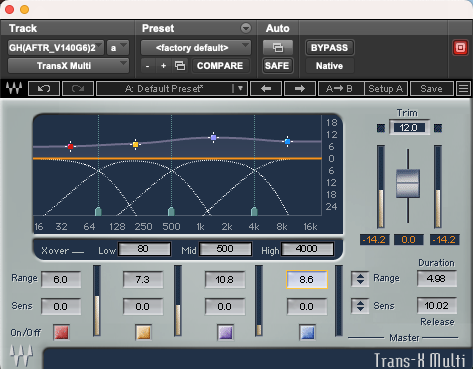Having worked as a Hip Hop and Rap engineer for over 15 years, I come across beats of all kinds on a daily basis. Whether self-made or purchased, these beats often present common mix or production issues that can really hinder a vocalist. In this article, we’ll delve into some prevalent mistakes that I have encountered over the years.
The Hi-Hats Conundrum
A recurring issue that I have noticed is that the hi-hats and cymbals overpower other instruments. This can be attributed to poor monitoring conditions or oversight during mixing. The main issue with having hi hats or cymbals dominate is that it hampers vocal articulation in the crucial 3.5kHz to 8kHz range. To mitigate this, careful consideration during the original mix is essential, avoiding unnecessary EQ adjustments later. Checking and adjusting hi-hat levels before sending a track to an artist ensures a balanced mix and allows the vocals to shine.
The 808 and Kick Drum Conundrum
Everyone loves a good 808, and everyone loves a punchy kick drum, but unless they work together, you won’t be able to hear any of them (at least not clearly). If you find that you like the sound of an 808, but the kick drum that plays on top of it is clashing, consider trying to following:
- Move the bass a little to the left or right to align it in phase with the kick drum. This is a good solution if when the kick drum comes in they both lose impact. You can also try flipping the polarity of the kick or bass to see if they sit better.
- Shorten the length of the kick drum so that it has the punch, but not the sub. A less commonly known fact is that the low sub of a kick drum is generally located at its tail. By shortening the length you can get a tighter kick drum that still has punch but doesn’t interfere with the sub of the 808.
- The kick doesn’t have enough bite. The thing about kick drums is that they normally don’t need to be as loud in the mix as you think they do-they just need to be heard. A way to get a kick drum heard, especially if it is a subby kick playing against a low 808, is to add some upper mids with an EQ, or harmonic saturator. If the kick has enough harmonic content in the upper mids but they are low, then an EQ can help bring those out. If the kick drum doesn’t have much high end information to begin with, adding a saturator will give it some harmonic structure, and therefore definition against the 808.
- Sometimes adding a transient shaper to increase the attack of the kick drum can help it punch through the booming 808. (pro trick: sometimes reducing the transients on the bass can have the same effect)

Waves Audio Trans-X Multi adding attack to a kickdrum.
The Sample Conundrum
Sample-based hip-hop beats, often sourced from a record player whose pitch wheel was not locked to the center, can introduce pitch inconsistencies. Detuning instruments to match the sample helps, but it poses challenges down the road for pitch-based vocal mixing software like Autotune or Melodyne which depend on 440 hz tuning.. If you have a sample that you love but it’s out of tune with any other instrument you add, consider tuning the sample to 440hz, instead of detuning everything else to match.
Arrangement
As a producer, you want to consider your “vertical arrangement”. Unlike the more common “horizontal arrangement” that deals with various sections of a song as a whole (Chorus, Verse, Bridge etc), the vertical arrangement is the arrangement of overlapping sounds at any given moment. Does each sound sit in their own space? Does each sound have a specific purpose? Is there too much going on? Is there any room for vocals, or is it constricting due to a busy arrangement? These are all questions you as the producer should be asking yourself before handing it off to a vocalist.
Vocal Space
When it comes to leaving space for vocals, as I mentioned, effective arrangement always comes first. Sometimes however you may like how a beat “feels” but not how it sounds. Instead of changing the arrangement , break out your tools and get sculpting! I’ll find that if there is a problem with the vocals sitting within the track, there may be excessive buildup in the 250 Hz to 600 Hz range. Similar to hi hats where they may overshadow the articulation region of vocals, you also want to make sure not to overshadow the mids, or the “body” of vocals. Create space in this area, and the vocalist and mix engineer will love you!

Make sure not to overcloud this area in your beat so that the vocals have space.
Conclusion
The key with all of these tips is to try to think from the perspective of the vocalist when writing your instrumentals. By anticipating how artists interpret and engage with the music, producers can create beats that are clutter free, easy to write to and not for nothing, easier to sell too!
About PIVODIO™ Coach Dan Zorn
Starting as a House Music producer under the alias “Dan Ryan”, Dan Zorn quickly found his way into the Chicago Club scene. After graduating from Columbia College in 2012, Dan began engineering at Studio 11, a legendary recording studio in downtown Chicago. Having worked with major label artists signed to Universal, Warner, Atlantic, and Def Jam and being an Award-Winning Content Creator for 𝗪𝗮𝘃𝗲𝘀 𝗔𝘂𝗱𝗶𝗼 𝗮𝗻𝗱 𝗥𝗲𝘃𝗲𝗿𝗯.𝗰𝗼𝗺, it’s safe to say this is one dude who lives and breathes music. Since his time in Chicago began, Dan has grown a reputation for his unique engineering style- merging his musical production chops into every mix he works on. The result is always an end product that resonates with a high level of musical understanding and a keen sense of technical mastery – creating mixes that excite all who listen.




Leave a comment